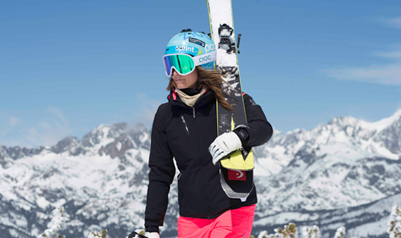Ski Clothing Tips Every Woman Can Use to Stay Warm on the Slopes
Posted
by
WinterWomen
on Sunday, October 4, 2015
WinterWomen's Guide to Women's Ski Clothes
 Whether you’re flying to the Rockies or spending the weekend in Tahoe, the key to enjoying any ski vacation is having the proper attire. However, if it's your first ski trip—or you only do this once or twice a year–remembering everything can be a daunting task. To make packing as simple as possible, we created this handy guide on women's ski clothing. Whether you’re flying to the Rockies or spending the weekend in Tahoe, the key to enjoying any ski vacation is having the proper attire. However, if it's your first ski trip—or you only do this once or twice a year–remembering everything can be a daunting task. To make packing as simple as possible, we created this handy guide on women's ski clothing.
You can divide ladies' ski clothes into three major categories:
- Layering
- Outerwear
- Accessories
How to Layer with Women's Ski Clothing
You may own the warmest, most waterproof ski jacket on the market, but without proper layering underneath, it won’t perform as it should. A woman's basic layering can be categorized into one of two groups – baselayers and midlayers.
Baselayers are anything next to skin, such as t-shirts and long underwear. These pieces should be extremely comfortable and breathable and should be made from moisture-wicking fabrics. Wool, polyester blends and other synthetics make for great baselayers because they are light, wick away moisture and provide good warmth. However, avoid baselayers made from cotton because it will trap moist hot air against your body. Once that air cools, you’ll freeze even in the warmest ski jacket.
Midlayers are meant to go over your base, providing additional warmth and breathability. Qualities of a good midlayer should mirror those of your base. Again, wool and synthetic blends are your best bet. This includes fleece layering pieces and jackets. A good fleece jacket or pullover can go a long way as a midlayer, providing extra warmth on cold days or when the wind is really whipping. Just make sure the fleece breathes well.
Using Women's Outerwear to Your Advantage
All of your ski clothing, including jackets and ski pants, should be warm and waterproof. Acting as your first line of defense against the cold, pants and jackets should shed all water and ensure that your base and midlayers stay dry.
Most modern ladies' ski clothes will meet these quality standards, so choose the jacket and pants with the features and fit you desire. Common features include adjustable or removable powder skirts, interior pockets (great for ski goggles and your iPhone) and, in more premium garments, removable liners. Down jackets and 3-in-1 systems are the warmest of the warm.
Choosing the Right Accessories for Your Ski Outfit
Now we come to the final portion of your outfit—the accessories. This category, much broader than the previous two, can include (but is not limited to) the following:
- Hats
- Goggles
- Gloves/Mittens
- Socks
When it comes to women's ski clothing, headwear warmth does not vary much. Just be sure to pick something that isn’t too thick for conditions.
You need to be more selective about goggles. To protect your eyes, make sure you choose the right lens tint. Certain lenses, such as rose and orange tints, are made for lower light conditions, whereas mirrored lenses work best for more intensely sunny days. Some brands sell multiple lenses with their goggles, which is a big plus.
For gloves and mittens, anything with Gore-Tex provides maximum waterproofing, but isn’t essential. Typically, you can gauge the warmth of a pair of gloves or mittens by price. Normally, the warmest, comfiest gloves are the most expensive, as they include the most material and technical fabric. When it comes to choosing between mittens and gloves, it’s a personal decision. If you get cold hands easily or will face extremely cold temps, mittens are a better option. However, if you want additional dexterity, or your hands often overheat, gloves are a good choice.
Socks can be very important for having a long, enjoyable day on the hill. Similar to layering, wool and synthetics dominate because of their breathability and ability to wick moisture. Many ski socks come with varying degrees of cushioning. Choosing socks with light, mid-range or heavy cushioning depends on personal preference and skiing ability. If you are skiing in average to slightly warmer temps on traditional terrain, light or even mid-level socks should be fine. Colder temps accompanied by jumps, moguls and more warrant a mid or heavy sock to help with warmth and shock absorption.
There you have it! We hope you find our guide to ladies' ski clothes helpful as you pack - and the perfect way to prepare for a comfortable, fun ski trip. Enjoy!
If you have specific questions about ski clothing for women, contact us! Our in-house experts can help.
Save
Save
Categories:
Ski & Ride
Tagged: Designer Ski Clothes, How to Layer, Ski Clothes, Ski Clothing
« Previous Post
Next Post »
|